Free State of Renasia
This article refers to a micronation or element of micronationalism which is defunct and no longer exists. You can help make the article reflect that or ask on the talk page for further information. |
| Motto: "Omnes unum fieri" All become one | |||||||||||||||||||
 Dots indicate FS Renasian Claims | |||||||||||||||||||
| Capital | None | ||||||||||||||||||
| Largest city | Seconda Territory | ||||||||||||||||||
| Official languages | English (Veletan and Russian recognised) | ||||||||||||||||||
| Demonym(s) | Renasian | ||||||||||||||||||
| Government | Constitutional Meritarchy | ||||||||||||||||||
• Meritarch | Jacob Tierney | ||||||||||||||||||
• Chancellor | Joshua Isaac | ||||||||||||||||||
• Supreme Judge | Samuel Azehtyla | ||||||||||||||||||
| Legislature | Guntanu'tl | ||||||||||||||||||
| Establishment | 2011 | ||||||||||||||||||
| Population | |||||||||||||||||||
• Census | no census yet conducted | ||||||||||||||||||
| Currency | Pecune | ||||||||||||||||||
Website Official newspaper | |||||||||||||||||||
| |||||||||||||||||||
The Free State of Renasia (Veletan: Renaziahu'gr' Tucco'rutl, Russian: Свободное Государство Реназия), sometimes more simply referred to as Renasia (Veletan: Renaziahu'tl, Russian: Реназия), was a small English-speaking micronation surrounded by the United Kingdom, the United States, and Canada. It was a member of the Grand Unified Micronational, in which it held the ceremonial 'Founder' position.
Renasia Proper was primarily located near the United Kingdom, with inhabited claims near Hertfordshire, UK, Edinburgh, UK, and Derby, UK. Gishabrun SAR was primarily located in North America and the Middle East, with claims near Toronto, Ontario, Canada, Sarasota, Florida, USA, Imishli, Azerbaijan and Manchester, UK. Azehtyl SAR was primarily located near the United States, with claims near Cincinnati, Ohio, USA and Camden, Maine, USA. Kozuc SAR was primarily located in the United States, with claims near California. Eridu SAR was primarily located in the United States, with inhabited claims in Baltimore, Maryland, USA and uninhabited claims to Kingman Reef in the North Pacific and Monowai Seamount.
Renasia was a part of the Scientopian Legacy, a socio-legal continuum that traced Renasia's roots back to 2008, when it first arrived on Microwiki as Scientopia. It helped to build up the community, with others who were around at the time, and created the Grand Unified Micronational. Its strong commitment to scientific and technological advancement set it aside for a majority of its existence, but now with organisations like the Sovereign Order of the Open Book more technocratic and science oriented nations have emerged, creating a sub-culture within the MicroWiki.
Renasia was a developed micronation, with a heavy focus developing economic growth and activity. It had a unique currency in the Pecune and holds a stock of silver and macronational currency, to back up its worth. It had a defined culture, and an extensive scientific background, much of which was held under the umbrella state-corporation known as Multiplex Technical. It was also part of the Saint Josephsburg Economic Pact, and had been since near the organisation's inception. With a heavy focus on advancing technologically, Renasia stood as MicroWiki's first Technocratic, science-focused nation.
The Free State of Renasia was disbanded after a referendum on May 5, 2015.
Etymology
The name Renasia can be broken down into three roots: Re-, -nasci- and -aṣû. The first and second are Latin; re- denoting that an action occurs again; -nasci- denoting the action of birth, or being born; finally -aṣû, which is Akkadian meaning "to ascend" or "to go outside". This was also one of the suggest etymologies for the word "Asia" although this was by no means universally accepted. The term Free State was used in recognition of two of its most common historical utilisations: Renasia was both asserting sovereignty, and also autonomy within a larger state which currently exercises control over it.
Scientopian Legacy
The Scientopian Legacy was both a legal and cultural successorship of states (or the permutations of a single state, depending on one's view of legal successors) which traces the history and legal foundation of Renasia back to its recognised legal foundation in September 2008 in the form of Scientopia. Whilst much has changed; both in terms of citizenship and legal-political architecture; this succession of forms was widely recognised to be legally valid both within Renasia and without. It was thus a single stand of legal continuity which remains unsevered and traces Renasia's lineage back to the foundations of the modern MicroWiki Community.
It was also a vital part of national identity, with Renasians on the whole recognising themselves as carrying the torch for the nobler ideals of the Scientopian state, whilst continuing to progress and participate in the evolution of those ideals. Whilst such actions might be considered to be a revision of the ideals of Scientopia, it should of course be noted that key amongst those ideals was reason and progress. These together necessitate evolution and change in the face of the ever-changing cultural and political landscapes both within and without.
Scientopia

Scientopia was founded on September 17 2008 by Jacob Tierney, with the intention of creating a micronation that would focus chiefly on scientific and technological development. Originally largely an Autocracy, the lack of people's representation quickly led to the development of a system of "Weighted Democracy" whereby each layer of the stratified political system was assigned a set percentage of the nation's vote. The highest level of this system, the "Diarchy" held 40% of the vote, and consisted of two figures, the Tzar Royale and the Supreme Overlord. Below this level the "Cabinet"; consisted of the three ministers for Home, Foreign and Military Affairs; held a further 30% of the vote. Finally, the rest of Government held 20% of the systems electoral power; leaving the lay public with 10% of the electoral power in any given election. Only the positions of the Diarchy were up for election, with all other government officials appointed by the Diarchy without input or feedback from the people.
Scientopia took an active role in the formative early years of the community, most notably sending out an official communiqué in December 2008 which resulted in the uniting of key members of the MicroWiki Community in the foundation of the Grand Unified Micronational in January 2009. This was widely considered to be Scientopia's lasting contribution to the community (outside of the continued "Scientopian Legacy" of which Renasia was current heir). This was because the GUM was an institution that has undeniably had a major impact on the wiki's community, regardless of whether this impact is considered to be positive or negative. Scientopia was by no means a purely diplomatic entity on the intermicronational stage however, notably involving itself in both espionage (Operation White Rose) and in outright declarations of war (both the Meissner-Antifan War and the Camurian War).
In its later days, due to internal pressures for increased democracy and social development, Scientopia lessened the stratification of its internal structure, allowing citizens greater power in the political process and moving the state from a rigid centralism towards left social and economic policy: this was a trend which would continue as time progressed.
New Scientopia and The R.R.R.

In April 2009, Scientopia found itself plagued by a potentially fatal political division. The national government, in particular Tzar Tierney, had long been uncomfortable with the incumbent Supreme Overlord Proud, a senior leader who they felt was not truly dedicated to the ideals of the nation. It was decided that he should be removed and replaced by a new political figure Suzerain Josh Lee.
This action was legally a grey area, as the majority rule of the government was absolute, but equally the positions of the Diarchy were constitutionally elected democratically. Proud responded by declaring that he was breaking away from the national government to establish "PartyHardtopia", a supposed separatist movement which soon fizzled out. This split is known historically as the Scientopian Divide, and is considered to be the begin of a decline which would eventually lead to complete inactivity.
In attempts to repair the damage the split wrought, Tzar Tierney renamed the nation to New Scientopia. This was in order to distinguish the new order from the old, and to help sanitise the split. In the wake of this renaming, the government began to institute further democratic and social reforms: these were instated in order to aid in the process of recruiting new, more serious citizens. However, this attempt was unsuccessful, resulting in the amalgamation of many offices and placing great strain on officials who had previously been coping well with more moderate workloads. Ultimately, many of these positions became overloaded and were slowly neglected resulting in a slow exodus of citizens out of the nation.

This second loss of citizens ultimately proved most costly: the collapse of the citizen base with the loss of many involved political figures necessitated a further reform of the nation, which lead to the formation of the Renaissance Republic of Renasia in December 2009. The first instance of instituted minarchism, in the Legacy, the focus of the Renaissance Republic was citizen recruitment and cultural development, a swing away from the perceived overbearing focus on technological and economic development which had previous reigned. Ultimately, whilst the minarchist political framework proved to be fruitful in restoring activity to the state, the nation still lacked real citizen participation outside of a small core of politicos. In light of this, Renasia fell into full inactivity: some Renasians joined the ideologically and politically similar Egtavia, and it was considered that Renasia was functionally though not legally a part of Egtavia.
The intervening period with Renasia as part of Egtavia was a stable and peaceful period. Those Renasians who joined Egtavia integrated into Egtavian culture and worked side by side with Egtavian citizens: prominent members were even granted roles in defense and technology sectors. A legal union between the two states realised with the ratification of the Amalgamation Treaty, August 24, 2011 at the 2011 Intermicronational Summit in London, UK. However, on 6 September 2011, the union broke down. It came to light that Petya d'Égtavie had willingly deceived Jacob Tierney with regards to his intention and his word in dealing with a GUM dossier. This dossier was at the time in development, top secret and considered to be of the utmost importance. In light of this violation of trust, and of the legal conventions of the GUM, Renasia unilaterally terminated the Amalgamation Treaty and resumed full independence.
Technocratic Renasia

Following the dissolution of the Amalgamation Treaty, Technocratic Renasia was formed. Having learned much from Egtavia despite the issues that had broken apart the union, Technocratic Renasia was a temporary autocracy, set out as a transitional government and state from its inception. Jacob Tierney continued his role as appointed head, given regards to his long run and success previously. He was granted a one-year term as Renasian Imperator. This position, in its establishment, was outlined to only exist until such a time as a Constitution and full legislature could be instated.
In October 2011, Renasian Technical (more often referred to as RenTech), was founded. Set up as a joint company and research institute, in charge of all Renasian science and technology. It was established as a state-funded private company, but this was eventually changed to make RenTech a state-owned company. In this same month, the Pecune was created, giving Renasia her own currency. The Renasian Locus was set up in November 2011, giving both Renasians and non-Renasians key news, opinion pieces, and a view into Renasian culture. Currently Renasia's only news source, its stated aims are "to provide up to date news on Renasian internal affairs, along with occasional opinion pieces from, and interviews with, key politicians and figures of note".
By December 2011, a constitution had been written, running nearly five thousand words, outlining the rights and responsibilities of both citizen and state. However, not enough citizens to form a legislative chamber had been found, and thus the position of Imperator remained. This stalemate position persisted until April 2012, when Technocratic Renasia's role was fulfilled, and the transition to the Free State occurred, with the Imperator transitioning to the role of Speaker of the Consortium.
History
Emergence of SARs (2012)
The period which followed the transition to the Free State was one of growth and growing influence for Renasia. Projects began to form, including the Renasian Foundry Project which produced a functioning but unfortunately short lived solid fuel foundry for metal melting. Most importantly, it was in these early days that the single most important system in the shaping of the modern Free State was established: the SAR system, which allowed for the admission of whole other micronations into the Free State as so-called "Special Autonomous Regions". After a short and complicated initial foray into SAR politics with Monovia, ending with an early and amicable bilateral treaty termination, Renasia found a solid SAR in Gishabrun, lead by Kuri Kabanov.
Following the acceptance of Gishabrun, Renasian influence in the sector increased markedly. Arguably the largest factor in this effect was the effective integration of Gishbruni citizens into Renasia. As such Gishabruni influence and Renasian influence in the community were merged at that time. Other factors, however, include the election of (then Speaker) Tierney to the Chairmanship of the Grand Unified Micronational and Renasia's expansion into the power gap left behind by the initial stages of degradation of larger power blocs like Nemkhavia and the Federal Republic of St.Charlie. Ultimately, however, the system of heightened citizen involvement led to slow legislative process, and in November 2012 a new constitution was drafted and formally passed. This created the modern hybrid system of meritarchy, democracy and appointed judiciary.
Growth and government (2013)
In the wake of constitutional reform, Chancellor elections were held in December 2012, with Kuri Kabanov and fellow Gishabruni Sovetus taking both Chancellor and Vice Chancellor positions respectively. The Meritarchy was found then to consist of Jacob Tierney and Luke Hackel. The appointment of a Supreme Judge, however, was not forthcoming at that time. In February 2013 Samuel Azehtyla applied to Renasia after his departure from St. Charlie and his formation of Azehtyl. Azehtyl soon became the third micronation admitted to SAR status, forming a strong bond with both Renasia Proper (as the non-SAR territories of the Free State are known) and Gishabrun SAR.
In March 2013 Renasia accepted yet another SAR in the form of Kozuc SAR. Previously a member of the St. Charlian federation, and not known for their stability, many feared that Kozuc might be the first SAR to violate its SAR treaty: however, these fears proved unfounded and indeed at the time of writing Kozuc is still an SAR of Renasia, albeit an inactive one. Following Kozuc's admission, nominations for Supreme Judge were opened. Samuel Azehtyla was appointed to the belatedly nominated position, beating out both Riley Small and James E Wilary, both of Kozuc.

The period between March and October of 2013 were marked by peaceful and functional government; The Tabula Rasa Act (2013) annulled unilaterally all previous treaties in order to cleanse and order formal relations after years of adhocratic foreign relations had left finding treaties difficult or in some cases impossible due to lost data; April saw the final version of the Meritocratic Ratings Act, which made concrete the systems of meritocratic rating in Renasia; in May, the National Security Act 2013 set down the regulations and structure for proper National Security within the nations borders; in July, Tiana submitted an application to SAR, and was accepted, however no treaty was ever negotiated or signed and thus Tiana remains in a state of limbo with regards to SAR integration; finally, a project budget proposal for Azehtyl'n Project New Leaf was approved, in order to purchase chiptune production hardware.
Tierney's absence (2013-2014)
In October 2013 however, then Meritarch Tierney left Renasia, citing issues in the community for his decision to leave. This left a large hole in the political system of Renasia and ultimately Luke Hackel stepped up to fill the role of Meritarch with Petya d'Egtavie stepping in to fill the Vice-Meritarch position. These roles were eventually swapped, with the more active Petya taking the lead position in the Meritarchy.
A lull, characteristic of Renasian late year progress, was typified by a somewhat deeper inactivity than usual in Tierney's absence. However, overall the nation fared well. In January 2014 the Chancellor elections saw Kuri Kabanov elected for a second time, with Riley Small made Vice Chancellor. Following this, Constitutional Amendment 1 was passed: its most fundamental modification to constitutional law being the repeal of the "once yearly amendment" system, allowing the Guntanu'tl to amend the constitution at any time in a manner similar to the passing of legislation. This change ultimately reflected a need to correct errors in the constitution as its practices continued to be lived out. In May 2014, a bilateral treaty with Reylan Imperial Triumvirate was signed by the Chancellor in a state meeting with HIM Taeglan I Nihilus. It was also in this time that the beginnings of the Saint Josephsburg Economic Pact began to coalesce. This period also saw the beginnings of negotiations with Austenasia to accept a gift of land in Carshalton.
Return of Tierney and economic reform (2014)
In late May 2014, Tierney returned, resuming his Renasian citizenship and being made Vice Meritarch in recognition of his high Meritocratic rating and the relative inactivity of the then Vice Meritarch Hackel. This was accompanied first by his restoration as head of RenTech, and then by his renewal of interest in passing legislation as part of the Guntanu'tl. As a result, the 2014 legislative period was marked by an increase in legislation over the 2012 and 2013 legislative periods.
This period of increased legislative action saw in June; the claiming of the land formerly held by Egtavia, as all Egtavian citizens were now Renasians; the enacting of the provisions of the Saint Josephsburg Economic Pact; the alteration of the Saint Josephsburg Economic Pact agreement to include presidential tie-breakers and the ability to hold votes of no confidence; the claiming of land in Imishli, Azerbaijan by Gishabrun SAR named Kənd Oblast; and the acceptance of the area of land known as "The Zone" from Austenasia.
July then saw a period of inaction legislatively, before August then saw the next wave of legislation; The Multiplexing Act 2014 passed, creating Multiplex Technical as an umbrella state-corporation overseeing all other state-companies and overseen by the Guntanu'tl and the corporate president; The Guntanu'tl accepted Sebastian Schriber, also of Wyvern and Ashukovo, as a citizen of Gishabrun SAR; The Guntanu'tl approved the citizenship of Joshua Isaac; Eridu SAR was established as the first SAR to be created by a current citizen of Renasia, becoming the fourth current SAR of Renasia; and the SAR treaties of both Gishabrun and Azehtyl were renewed.
Metrication controversy and educational development (2014)
In August 2014, controversy erupted in Renasia. Joshua Isaac drafted a bill that became known as the SI Units Act (2014), which proposed to declare the SI unit system as Renasia's only official measurement system. This bill was staunchly opposed by Supreme Judge Samuel Azehtyla, as the Imperial system of measurement was the system most commonly used in Azehtyl SAR. As a result, he brought it to a vote in the ACRE which, if passed, would allow each SAR to decide whether to implement the law or not - a result known as "localisation". This localisation vote failed. In the Guntanu'tl, however, the vote came to a standstill with 2 in favour, 2 against, and one absent voter (as Vice Chancellor Riley Small had been unreachable and inactive for months). Supreme Judge Azehtyla ruled that such a prolonged absence was equivalent to a vote of abstention and, since the Guntanu'tl could not arrive at a decision, the bill had to be put to a national referendum. This referendum, in which a total of 15 citizens cast their votes, was decided in favour of a nationwide adoption of SI units by a 73% majority.
In September 2014, RenTech established its Chemo-Botanical Division (CBD), inaugurated with a project to grow Hawaiian Baby Woodrose from seeds. Gishabrun SAR, meanwhile, was expanding, with the claiming of Erephisia Oblast bordering the UK, on what was the former territory of the Technological Federation of Erephisia. Joshua Isaac, inspired by the SJEP provisions for intermicronational educational and credential-granting institutions, reformed the dormant Feynman Institute. Under the new model, the Feynman Institute would be primarily research-based, granting degrees based on the amount of peer-reviewed papers a student published, with no official classes or credits. Isaac was appointed the institute's Head Representative.
Decline and dissolution (2015)
Renasia's last Chancellor elections concluded in January 2015, with a record turnout of 11 voters. Chancellor Kuri Kabanov was re-elected for a third term, and Joshua Isaac was elected as Vice Chancellor. At some point in early 2015, Jacob Tierney again accepted the position of Meritarch, and Petya d'Egtavie became the Vice Meritarch.
In January 2015, Kozuc SAR officially dissolved due to inactivity after the prolonged imprisonment of its president, Riley Small. This occurred without the knowledge of the Renasian government due to a breakdown in communications between Kozuc SAR and the Guntanu'tl.
On March 17, 2015, after a prolonged period of inactivity, Knyaz Kuri Kabanov officially resigned from his position as Chancellor and dissolved the Gishabruni government in anticipation of no longer renewing the Gishabrun SAR treaty. This action left Joshua Isaac as the Chancellor of Renasia, with the Vice Chancellor position being vacant. The effective departure of one of the more active Renasian citizens shocked the nation, and Meritarch Tierney called a referendum on whether Renasia as a whole should be dissolved. This referendum, Renasia's last, was decided in the affirmative on May 5, 2015.
Government and politics

The Renasian political system was a hybrid system, consisting of several interlocking parts: one could argue that strictly speaking it was a direct democracy, as citizens had the right to veto every bill going through the legislature. However, most commonly, the Free State was initially described as a Hybrid Meritocratic Representative Democracy. Following the publication of "On Constitutional Meritarchy" at the end of August 2014, however, the system was formally named Constitutional Meritarchy, in parallel with Constitutional Monarchy. In particular, this document describes the Renasian enactment of this potentially broad system as "The Guntanu'tl Model".
Renasian politics were at times the politics of paradox; Renasia was a unitary state, but despite this there was often discussion of the 'regional' and 'federal' levels. This was due to the presence of Special Autonomous Regions (SARs) which have their own local governments, and thus regional issues concerning them; it had a unicameral legislature with an assembly which has certain powers over the legislature; the Renasian people are those who technically held power at all times, yet the de facto ruling of the country was done by the Guntanu'tl; and whilst there was an entrenched constitution, it could in practice be amended with the same ease as passing an act.
Organs
The Guntanu'tl (pronounced /gʰuntaˈɲytl/, from the Veletan for "intelligent council") was the sole legislative body in Renasia on the federal level. It consisted of five members, in three "branches"; The Chancellery, which consisted of the democratically elected Chancellor and their runner-up, the Vice Chancellor; The Meritarchy, consisted of the Meritarch (highest rated citizen) and their runner-up, the Vice Meritarch; and the Judiciary, whose sole member was the Supreme Judge appointed by members of the Chancellery and Meritarchy. Of particular importance were the Meritarch and Chancellor; they served together as Head of State.
The role of the Guntanu'tl was to act as both legislative and executive. Thus, any prospective Renasian declaration of war would be subject to its discretion. Among other things it could extend and terminate diplomatic relations; It controlled taxes, could both take out loans and extend loans to other nations; it set naturalisation procedures, and approved all new citizens; it held the right to call or dismiss a standing army, or call up a militia; it set budgets, monitored economic progress and of course acted as the board of directors for Multiplex Technical. Any and all of these functions could not be called on a whim, however, and require a voting procedure akin to that required for passing acts, though in some cases (e.g. declaration of state of emergency) the one week scrutiny period could be waived.
Of special interest was the Judiciary, the Supreme Judge. Their role was plural. Firstly, the Supreme Judge was the interpreter of the Constitution and the spirit of the law: if there was some ambiguity or disagreement in finding the meaning of some clause, their job was to assess and pass a judgement on the true interpretation. In this way, they were also the writers of a form of common law. Secondly, they held the dominion over any other courts in Renasia, and could establish other courts and appoint sub-judges beneath them. Finally, even when there were no cases of dispute, the Judiciary was held accountable for ensuring the constitutionality of any new acts passed by the Guntanu'tl.
The A.C.R.E. (pronounced /ˈɑːkər/ or /ˈeɪkər/) were the "Assembled Council of Regional Executives", an extra-constitutional advisory council which served to protect SARs' interests and highlight the issues which can be unique to regionally varied nations such as Renasia. The council was granted power by the Guntanu'tl, which reserved the right to dissolve the ACRE via a vote. The ACRE was assigned a limited range of powers which it could exert: in essence, it could only advise the Guntanu'tl on issues pertaining to the SARs or Renasia Proper, or it could instigate a vote on any act to instate the restriction known as "localisation". This action allowed individual regions, whether SAR or Renasia Proper, to opt into or out of the act which had been localised.
Regions
The Free State consisted of two kinds of regions; the Special Autonomous Regions, or SARs, which had their own local government, internal structure and culture; and Renasia Proper, the three territories which make up the rest of Renasia, which also had their own local government, internal structure and culture. Renasia Proper could be most sensibly contrasted from the SARs by the following qualities; it was part of Renasia without any kind of treaty binding it as such; it was the contracting party with which the SARs made their treaties; and it was the original territory of Renasia before the influx of the SARs onto the scene.

Renasia Proper
Renasia Proper, then, was the politically central region of Renasia. It controlled several claims within the United Kingdom, more specifically claims in Edinburgh, UK which included; HQ territory, which included the inhabited territory HQ Central, and the uninhabited claims which made up the Deltavie testing grounds, in the Pentlands to the south-west of HQ Central; Seconda territory, which consisted of both an inhabited claim in Hitchen, UK, and an uninhabited claim on the outskirts of Watton-at-Stone, UK; the unnamed ex-Egtavian territories, located near Derby, UK; and the Zone. It was the resident region of notable citizens Jacob Tierney, Luke Hackel and Petya d'Egtavie, all of whom have had positions in the Meritarchy at one time or another. Indeed, throughout Renasia's history, the entirety of the Meritarchy was composed of Arpiens (as in RP'ans).
Renasia Proper's system of government was in essence a complete anarchy: the region functioned as an unguided commune where mutual freedom was guaranteed in exchange for not harming or otherwise infringing the freedoms of others. Culturally, Renasia Proper had perhaps the least unique cultural capital. Instead, it seems mostly that it adopted the wide spectrum of "Renasian-ness" as fully as possible and deeply as possible: it was the most minarchist region and politically its members are more progressive than some others. It celebrated the free exercise of personal liberties, and was the region most heavily typified by anti-authoritarian streaks. The flag of Renasia Proper depicts a Hummingbird, a symbol of intellectual quickness and tireless energy, against a vertical bicolour of Renasian Blue and white. It is accompanied by the Broken Circle, a universal symbol of Renasia.
More prominently, Renasia Proper was the first region of Renasia to fully embrace cannabis culture, with free sharing of the plant amongst Arpien residents. This was most apparent when in early 2012 Jacob Tierney paid a state visit to another member of the so-called "Green Triangle", the USLSSR's Lewisham Democratic Republic, a state visit during which much discussion was had alongside the consumption of cannabis. Renasia Proper's other cultural claim, which was also later shared by Renasia at large, was being the first micronation to declare a secular patron saint: Saint Sagan of Renasia. Saint Sagan represents Renasia's emphasis on cosmic perspective, scientific discovery and responsible cannabis enthusiasm: being as he was an advocate of cannabis under the pseudonym Mr. X, an advocate of finding meaning through science and an inspiration to generations through his writing and television series.
In Brief
| Flag | Name | Admission | A.C.R.E. delegate(s) | No. of territories | Brief Description |
|---|---|---|---|---|---|

|
Renasia Proper | Original Region | Jacob Tierney | 4 | Renasia Proper was considered to be the original region of Renasia, before the inclusion of SARs. It controlled most of the territory bordering the UK, and had no claims anywhere else. It was the only region not considered an SAR. It had no formal internal government and was thus a regional anarchy. All citizens were sovereign so long as they did not violate Federal law. |

|
Gishabrun SAR | 22 July 2012 | Kuri Kabanov | 8 | Gishabrun SAR was the oldest SAR. Divided into eight territories: the four oblasts, which were inhabited; and the four krais, which were not; it was ruled as a constitutional monarchy, with a monarchical Kynaz at its head. It was state capitalist, with the company KleinZav being identical with its government. Spread across four macronations, its territories were disparate and varied. |
| Azehtyl SAR | 24 February 2013 | Samuel Azehtyla | 2 | Azehtyl SAR or City-State Azehtyl, was a Direct Democratic Freetown. It had two claims, both enclaves of the USA. It was one of two SARs which joined in 2013. Azehtyl's name derives from the chemical term Acetyl, found as part of the name of a revered substance in Azehtyl'n Paganism, O-acetylpsilocin. Along with St. Sagan, Azehtyl also admired St. McKenna. | |
| Kozuc SAR | 2 March 2013 | Riley Small | 2 | Kozuc SAR was found in California. Kozuc had 59 residents, making it the largest subdivision of Renasia, and thus a large voting base. As the only Special Administrative Division to border another micronation, the Empire of Frexico, the area was a large military and agricultural center for the Free State. Before joining Renasia, Kozuc was considered the third member of the Green Triangle. | |
| Eridu SAR | 16 August 2014 | Joshua Isaac | 1 | Eridu SAR was based in Baltimore, Maryland. It was a socialist state, aiming to apply socialist, communal and anti-materialistic economic and cultural values within its borders. The name Eridu comes from the Sumerian eridu; this could be translated as "mighty place" or "guidance place". |
Foreign relations
The Free State of Renasia had informal relations with a great deal of nations and had formalised only relations with those in Grand Unified Micronational by proxy of being in that organisation. The Free State of Renasia had what it considered good relations with the following nations, though this list is not exhaustive:
- Federal Republic of St.Charlie
- State of Sandus
- Empire of Austenasia
- Kingdom of Wyvern
- Ashukov Federation
- Reylan Imperial Triumvirate
Relations of special interest
![]() Saint Josephsburg Economic Pact: Renasia was one of the four founding members of the SJEP, an economic union, along with the Ashukov Federation, the Empire of Austenasia, and the State of Sandus. The SJEP promotes economic cooperation among member states by providing a common economic framework as well as removing barriers to trade.
Saint Josephsburg Economic Pact: Renasia was one of the four founding members of the SJEP, an economic union, along with the Ashukov Federation, the Empire of Austenasia, and the State of Sandus. The SJEP promotes economic cooperation among member states by providing a common economic framework as well as removing barriers to trade.
Economy
Renasia's economy was very minor, mainly involved with the sale of currency as souvenirs for collectors. However, sale of agricultural products had been planned since late 2013, and one product (Sumac powder) had already been produced and distributed. Renasia had formal economic relations only with the Reylan Imperial Triumvirate. and the Saint Josephsburg Economic Pact.
Currency
The Pecune was the currency unit utilised by the Free State of Renasia, the concept for which was created by Jacob Tierney just after the birth of Technocratic Renasia between the 8th of September and the 10th of September 2011. It had a proposed subunit, the Pecunette, not realised in any form. It was proposed every Pecune would break down into 64 Pecunettes.
It was to be a solely banknote based currency, with no coins planned. Each note shows on the obverse the likeness of a famous scientist or mathematician, their signature, and a quote from the relevant persona to inspire the values that made these men great into the hearts of the population.
The currency was backed by the Renasian silver reserve, with each Pecune only one nth of the treasury silver's net worth at a point where n Pecunes are in circulation. Only the 1þ, 5þ, 10þ and 20þ notes were ever issued.


